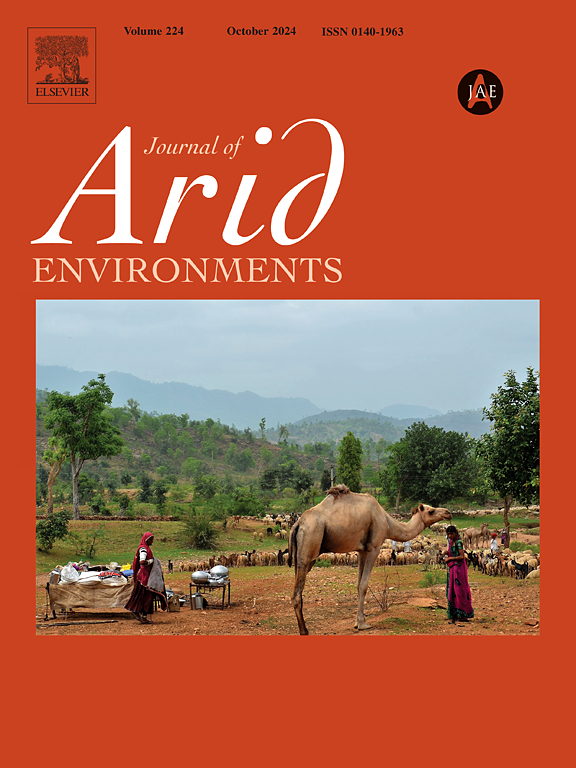不列颠哥伦比亚省半干旱奥肯那根河谷植被覆盖类型和范围对陆生小型哺乳动物的影响
IF 2.6
3区 环境科学与生态学
Q2 ECOLOGY
引用次数: 0
摘要
加拿大不列颠哥伦比亚省南部奥肯那根山谷的山间草地和灌木-草原牧场有着悠久的人为干扰历史。畜牧业、城市化和农业都在改变历史上的栖息地马赛克中发挥了作用。不到10%的半干旱草原仍处于自然状态,被几种陆生小型哺乳动物所占据。这些物种可以为了解生境变化的影响提供有用的见解,因为它们的丰度足以进行采样,可以在多个尺度上选择栖息地,并且受栖息地结构的强烈影响。我们调查了大量半干旱生境,大多数生境都有放牧的历史,并预测了本地草和牧草覆盖率高的生境,以及一定程度的垂直结构,将支持最高的总体丰度和物种多样性。1994年至1997年,我们在24个地点研究了小型哺乳动物群落,这些地点代表了广泛的生境条件,跨越了一系列植物物种组合。这24个地点覆盖了没有植物覆盖的矿质土壤暴露水平,范围从1.4%到27.2%不等。主要灌木的平均盖度为苦灌木(Purshia tridentata)为0% ~ 29.8%,艾草(Artemisia tridentata)为0% ~ 16.2%。牧草的平均盖度为21.6% ~ 69.5%。大盆地袋鼠(Perognathus parvus)为优势种(高密度年平均29-44只/ hm2),与灌木平均盖度呈显著正相关,至少在20%以上。鹿鼠(Peromyscus maniculatus)是第二丰富的物种(高密度年平均23-26只/ha),与草木平均盖度呈负相关。西部收获鼠(Reithrodontomys megalotis)的平均密度为5-6只/ha,与禾草生境呈正相关,与蒿生境无关。山地田鼠(Microtus montanus)的数量一直很低(2-3只/公顷,高密度时可达6-10只/公顷),并且与草木和牧草的覆盖缺乏任何关系,反映了这一关键物种的栖息地条件较差。总哺乳动物的平均丰度和物种多样性与植被覆盖密度呈正相关,从而表明在一定程度上保护了捕食者。本文章由计算机程序翻译,如有差异,请以英文原文为准。
Effect of type and extent of vegetative cover on terrestrial small mammals in the semi-arid Okanagan Valley, British Columbia
The intermontane grasslands and shrub-steppe rangelands of the Okanagan Valley of southern British Columbia, Canada have a long history of anthropogenic disturbances. Livestock grazing, urbanization and agriculture have all played roles in altering the historic habitat mosaic. Less than 10% of semi-arid grasslands remain in a natural state and are occupied by several species of terrestrial small mammals. These species may provide useful insight into the effects of habitat alteration because they occur in sufficient abundance for sampling, select habitat at multiple scales, and are strongly influenced by habitat structures. We investigated a wide range of semi-arid habitats, most with a history of livestock grazing, and predicted that habitats with a high percentage cover of native grasses and forbs, and some degree of vertical structure, would support the highest overall abundance and species diversity of small mammals. We studied small mammal communities from 1994 to 1997 on 24 sites selected to represent a wide variety of habitat conditions that spanned a range of plant species assemblages. The 24 sites covered a range of levels of mineral soil exposure with no plant cover ranging from 1.4% to 27.2%. Mean cover of major shrubs were bitterbrush (Purshia tridentata) that ranged from 0% to 29.8% and sagebrush (Artemisia tridentata) that ranged from 0% to 16.2%. Mean cover of grass-forbs ranged from 21.6% to 69.5%. The Great Basin pocket mouse (Perognathus parvus) was the dominant species numerically (mean of 29–44 mice/ha in high density years) and showed a strong positive relationship to mean cover of total shrubs, at least above 20% ground cover. The deer mouse (Peromyscus maniculatus) was the second most abundant species (mean of 23–26/ha in high density years) with a negative correlation of mean cover of grasses and forbs. The western harvest mouse (Reithrodontomys megalotis) reached mean densities of 5–6/ha and was positively correlated with grass-forb sites but not Artemisia-dominated sites. The consistently low numbers of montane voles (Microtus montanus) (2–3/ha, up to 6–10/ha at high densities) and lack of any relationship with cover of grasses and forbs reflected the poor habitat conditions for this keystone species. Mean abundance and species diversity of total mammals were positively correlated with a measure of vegetation cover density, thereby suggesting that some degree of protection from predators was perceived.
求助全文
通过发布文献求助,成功后即可免费获取论文全文。
去求助
来源期刊

Journal of Arid Environments
环境科学-环境科学
CiteScore
5.70
自引率
3.70%
发文量
144
审稿时长
55 days
期刊介绍:
The Journal of Arid Environments is an international journal publishing original scientific and technical research articles on physical, biological and cultural aspects of arid, semi-arid, and desert environments. As a forum of multi-disciplinary and interdisciplinary dialogue it addresses research on all aspects of arid environments and their past, present and future use.
 求助内容:
求助内容: 应助结果提醒方式:
应助结果提醒方式:


